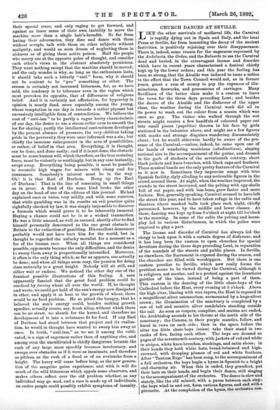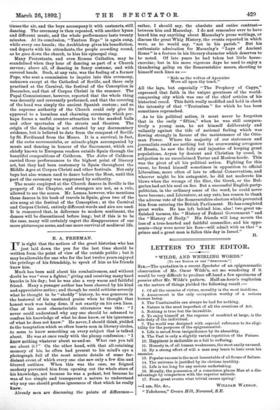CHURCH DANCES AT SEVILLE.
LIKE the other survivals of medireval life, the Carnival is rapidly dying out in Spain and Italy, and the local Press at Seville, far from lamenting the decay of the ancient festivities, is positively rejoicing over their disappearance. There is, indeed, some reason for the eagerness expressed by the Andalucia, the Orden, and the Baluarte to see the Carnival dead and buried, in the extravagant license and disorder which have in recent years characterised a festival chiefly kept up by the lower orders; and this year the feeling has been so strong, that the Alcalde was induced to issue a notice to the effect that the Town Council would not, as in former years, grant a sum of money to pay the expenses of illu- minations, fireworks, and processions of carriages. Many Sevillians of the better class make it a custom to leave the town for the three days preceding Lent; and besides the decree of the Alcalde and the disfavour of the upper class, the weather during the Carnival week did all in its power to wash out the colour from a season which was once so gay. The visitor who walked through the wet streets might receive a few handfuls of coloured paper out into small pieces (papelitos) thrown in his face by girls stationed in the balconies above, and might see a few figures with masks and strange disguises wandering disconsolately about; but he would otherwise hardly be aware of the pre- sence of the Carnival,—unless, indeed, he came upon one of the bands of wandering musicians (estudiantinas), singing national airs to the accompaniment of the guitar, and dressed in the garb of students of the seventeenth century, short black jackets and knee-breeches, with black caps and feathers. These musical bands are the only pretty feature of the Carnival as it now is. Sometimes they improvise songs with true Spanish facility, slyly alluding to any noticeable figures in the crowd around them. At night, when the weather improved, the crowds in the street increased, and the pelting with egg-shells full of cut paper, and with bon-bons, grew faster and more furious. But, generally speaking, Carnival seemed to have left the street this year, and to have taken refuge in the cafes and theatres, where masked balls took place each night, chiefly patronised, however, by the middle and lower classes. At these, dancing was kept up from 9 o'clock at night till 5 o'clock in the morning. In some of the cafés the pelting and horse- play led to various disturbances, in which the police were required to play a part.
The license and disorder of Carnival has always led the clergy to look upon it with a certain degree of disfavour, and it has long been the custom to open churches for special devotions during the three days preceding Lent, in reparation of the scandals of the streets and public places. In Seville, as elsewhere, the Sacrament is exposed during the season, and the churches are filled with worshippers. But there is one custom peculiar to Seville, which now really forms the prettiest scene to be viewed during the Carnival, although it is religious, not secular, and is a protest against the licentious gaieties of the time, instead of being a part of them. This custom is the dancing of the little choir-boys of the Cathedral before the Host, every evening at 5 o'clock. Above the high altar, blazing with wax-tapers, the Host is exposed in a magnificent silver ostensorium, surmounted by a huge silver crown; the illumination of the sanctuary is completed by a row of tall and massive silver candelabra standing outside the rail. As soon as vespers, compline, and matins are ended, the Archbishop ascends to his throne at the north side of the sanctuary; the Canons, in their purple mantles, follow, and kneel in rows on each side; then in the space before the altar ten little choir-boys (seises) take their stand in two ranks of five, facing each other. The boys are dressed as pages of the seventeenth century, with jackets of red and white in stripes, white knee-breeches, stockings, and satin shoes; in their hands they hold white hate, broad-brimmed and high crowned, with drooping plumes of red and white feathers. After " Tantum Ergo" has been sung, to the accompaniment of a full orchestra, the boys begin a hymn in Spanish to a bright and charming air. When this is ended, they genuflect, put their hats on their heads, and begin their dance, still singing to the accompaniment of the orchestra. The dance is slow and stately, like the old minuet, with a pause between each step; the boys wind in and out, form various figures, and end with a pirouette. At the completion of the hymn, the orchestra con-
tinues the air, and the boys accompany it with castanets, still dancing. The ceremony is then repeated, with another hymn and different music, and the whole performance lasts twenty minutes. At its conclusion, " Tantura Ergo" is again sung, while every one kneels; the Archbishop gives his benediction, and departs with his attendants, the people crowding round, as he goes down the church, to kiss his episcopal ring.
Many Protestants, and even Roman Catholics, may be scandalised when they hear of dancing as part of a Church service; above all, of dancing in fancy costume, and with covered heads. Such, at any rate, was the feeling of a former Pope, who sent a commission to inquire into this ceremony, unknown except at the Cathedral of Seville, and there only practised at the Carnival, the festival of the Conception in December, and that of Corpus Christi in the summer. The Papal Commissioner, however, reported that the whole thing was decently and reverently performed, and that the covering -of the head was simply the ancient Spanish custom ; and so the supreme authority of the Church could only give its approval to a harmless and charming ceremony, which per- haps forms a useful counter-attraction to the masked balls -and other spectacles of the streets and theatres. The -origin of the dancing is not attested by any documentary evidence, but is believed to date from the conquest of Seville by St. Ferdinand from the Moors. It is a survival, in fact, of the autos sacramentales, or miracle-plays accompanied by music and dancing in honour of the Sacrament, which are chiefly known to European readers outside Spain through the beautiful compositions of Calderon. The Autos of Calderon carried these performances to the highest point of literary art, but they had been customary in Spain throughout the Middle Ages at Corpus Christi and other festivals. Not only boys but also women used to dance before the Host, until this part of the ceremony was suppressed by authority.
The music employed at the Church dances in Seville is the property of the Chapter, and strangers are not, as a rule, allowed to see the scores. Mr. Lomas, however, who mentions these dances in his book of travels in Spain, gives two of the airs sung at the festival of the Conception ; at the Carnival -and Corpus Christi, entirely different words and airs are used. It is rumoured that, in deference to modern sentiment, the -dances will be discontinued before long; but if this is to be the case, many will certainly regret the disappearance of one more picturesque scene, and one more survival of medimval life.



































 Previous page
Previous page